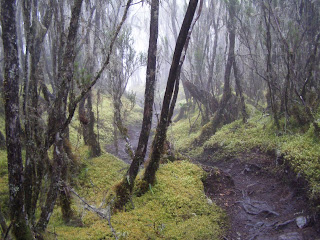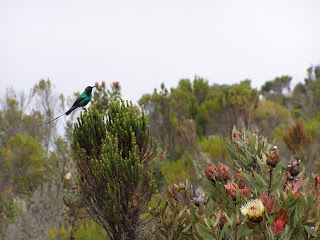Ob 11h zvečer smo odrinili proti vrhu, nas pet turistov in trije vodniki, razen naše skupine pa še številni drugi turisti s svojimi vodniki. Temperatura je bila pod ničlo, ko smo se vzpenjali, pa je postajalo vedno hladneje. Težko smo dihali zaradi višine in po skoraj štirih urah sopihanja v temi navzgor na nadmorski višini kakih 5300 m je sina premagala višinska bolezen, tako da ni več vedel, kje je in kam gre, zato sta se z Markom obrnila nazaj in se v spremstvu vodnika vrnila v kamp. Olga, Linda in jaz pa smo se ob pomoči preostalih dveh vodnikov prebijale naprej.
V nadaljevanju je zvilo Olgo. Bruhala je, a ji je bilo potem bolje in smo šli naprej. Naslednja je bila na vrsti Linda, ki je omedlela, na srečo jo je vodnik pravočasno ujel. Vsedli smo se na skale, popili nekaj požirkov vode in pojedli košček energetske ploščice, Linda se je ozavestila in smo odrinili naprej. Dalj časa počivati ni bilo mogoče, saj bi zaradi mraza verjetno pozebli. Bilo je zelo naporno in nisem se mogla odločiti, ali naj raje bruham, ali omedlim. Razmišljala sem, da če omedlim, ne bom mogla naprej, nazaj pa je bilo tudi vprašljivo, ali bi me kdo nesel, za bruhanje pa mi tudi ni bilo preveč, čeprav mi je bilo slabo. Začelo me je zebsti v prste na nogah in me je zaskrbelo zaradi omrzlin, pa sem se spomnila, da je treba migati s prsti na nogah, da jih ogrejem. Skoncentrirala sem se na pomikanje naprej, počasi, najprej ena noga naprej, vdih in izdih, pomigati s prsti, potem druga noga naprej, vdih in izdih in tako dalje, ure in ure v temi in mrazu po serpentinah navzgor. Še dobro, da je bila tema, sicer če bi vnaprej videla, kako daleč je treba še prilesti, bi morda izgubila voljo. Voda, ki sem jo imela za pitje, je začela zmrzovati, zato sem prestavila pollitersko plastenko v notranji žep bunde. Najbolj sem si želela, da bi se zdanilo, a kar ni hotelo postati svetlo.
Šele ko smo se po sedmih urah hoje končno privlekli na greben, na točko imenovano Stella Point na nadmorski višini okrog 5700 m, se je začelo nekoliko svetlikati na obzorju. Imeli pa smo še dobre pol ure in 100 višinskih metrov poti po grebenu do vrha. Poskusila sem ugasniti naglavno svetilko, ki sem jo imela prižgano vso pot, a skozi rokavico nisem občutila gumba, zato sem snela rokavico in jo ugasnila, bilo pa je tako mrzlo, da sem potem še nekaj časa ogrevala roko. Na vrhu smo se na hitro fotografirali, potem pa se obrnili nazaj, saj zaradi vetra in mraza ni bilo možno posedanje in občudovanje razgleda. Na grebenu je sicer sneg, a ga ni prav veliko, večji del poti je kopen. To, kar se iz daljave vidi kot sneg na Kilimanjaru, je v resnici sosednji ledenik. |
All five of us, along with our three guides started the summit climb at 11 PM. In addition to our group there were countless other tourists with their guides. The temperature was below freezing when we started and it only got colder as we ascended. We had difficulty breathing due to the altitude and after almost four hours of gruelling climbing at an altitude of about 5300 m our son succumbed to altitude sickness. He became disoriented and so Marko decided that they should return back down to camp accompanied by one of the guides. Olga, Linda and I continued our way up supported by the remaining two guides.
The next victim was Olga. She vomited but she felt better after that and so we continued. Then Linda fainted and the guide was fortunately there to catch her before she fell. We sat down for a while, drank a few sips of water and ate a bite off an energy bar. Linda came to and we continued. We couldn't rest longer because we could get frostbite. It was very tough and I couldn't decide whether I should vomit or faint. I thought that if I faint, I couldn't go on and they probably wouldn't carry me back down and I didn't feel like vomiting although I was nauseous. My toes were cold and I remembered that I need to move them to increase circulation. I concentrated on moving forward slowly, first one leg, then the other, inhale and exhale, wiggle my toes and so on, hours and hours on end in the dark and the cold on the winding path upwards. Since it was dark I couldn't see how much further the path went and I'm glad that I didn't know or I might have become discouraged. My drinking water started freezing so I placed the bottle in the inside pocket of my parka. I wished so much for daylight that just wouldn't come.
Only after seven hours of going uphill, when we reached the Stella Point on the ridge at an altitude of about 5700 m, a promise of dawn showed on the horizon. We still had a good half hour and about 100 m of altitude to go. I tried to switch off my headlamp that I used during my climb but I couldn't do it with my glove. I removed the glove just to do that but it was so cold that I spent some time after that warming back my hand. At the summit we took a few minutes to take photos and immediately turned back as it was much too cold and windy to hang around and admire the view. There is some snow on the ridge, but not much as most of the path is dry. What looks like the snows of Kilimanjaro from afar is actually the neighboring glacier. |

































